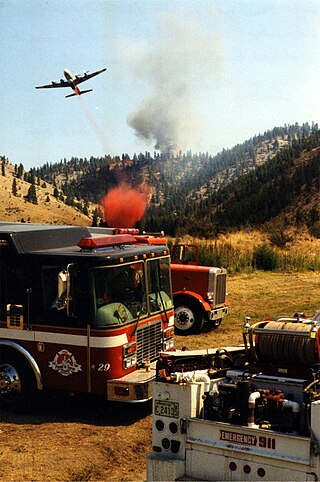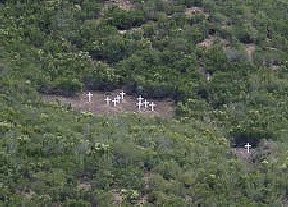
A firefighter is a first responder trained in firefighting, primarily to control and extinguish fires that threaten life and property, as well as to rescue persons from confinement or dangerous situations. Male firefighters are sometimes referred to as firemen.

A fire department or fire brigade, also known as a fire company, fire authority, fire district, fire and rescue, or fire service in some areas, is an organization that provides fire prevention and fire suppression services as well as other rescue services.

Florian was a Christian holy man and the patron saint of chimney sweeps; soapmakers, and firefighters. His feast day is 4 May. Florian is also the patron saint of Poland, the city of Linz, Austria, and Upper Austria, jointly with Leopold III, Margrave of Austria.

Firefighting is a profession aimed at controlling and extinguishing fire. A person who engages in firefighting is known as a firefighter or fireman. Firefighters typically undergo a high degree of technical training. This involves structural firefighting and wildland firefighting. Specialized training includes aircraft firefighting, shipboard firefighting, aerial firefighting, maritime firefighting, and proximity firefighting.

Aerial firefighting, also known as waterbombing, is the use of aircraft and other aerial resources to combat wildfires. The types of aircraft used include fixed-wing aircraft and helicopters. Smokejumpers and rappellers are also classified as aerial firefighters, delivered to the fire by parachute from a variety of fixed-wing aircraft, or rappelling from helicopters. Chemicals used to fight fires may include water, water enhancers such as foams and gels, and specially formulated fire retardants such as Phos-Chek.
The Linton Bushfire was a wildfire that burned through private land and state forests near the township of Linton, Victoria, Australia on 2 December 1998. Firefighters from the Victorian state government's Department of Natural Resources and Environment and the Country Fire Authority (CFA) were deployed to put out the fire. At approximately 8.45pm, two firefighting appliances and their crews were entrapped and engulfed in fire following an unexpected wind change. The bushfire covered a maximum land of 660 hectares of private and public land.
Firefighting jargon includes a diverse lexicon of both common and idiosyncratic terms. One problem that exists in trying to create a list such as this is that much of the terminology used by a particular department is specifically defined in their particular standing operating procedures, such that two departments may have completely different terms for the same thing. For example, depending on whom one asks, a safety team may be referred to as a standby, a RIT or RIG or RIC, or a FAST. Furthermore, a department may change a definition within its SOP, such that one year it may be RIT, and the next RIG or RIC.
This glossary of wildfire terms is a list of definitions of terms and concepts relevant to wildfires and wildland firefighting. Except where noted, terms have largely been sourced from a 1998 Fireline Handbook transcribed for a Conflict 21 counter-terrorism studies website by the Air National Guard.
The National Day of Mourning, or Workers' Mourning Day is observed in Canada on 28 April. It commemorates workers who have been killed, injured or suffered illness due to workplace related hazards and occupational exposures.

Wildfire suppression is a range of firefighting tactics used to suppress wildfires. Firefighting efforts in wild land areas require different techniques, equipment, and training from the more familiar structure fire fighting found in populated areas. Working in conjunction with specially designed aerial firefighting aircraft, these wildfire-trained crews suppress flames, construct fire lines, and extinguish flames and areas of heat to protect resources and natural wilderness. Wildfire suppression also addresses the issues of the wildland–urban interface, where populated areas border with wild land areas.
The following outline is provided as an overview of and topical guide to firefighting:

The Rattlesnake Fire was a wildfire started by an arsonist on July 9, 1953, in Powder House Canyon on the Mendocino National Forest in northern California. The wildfire killed one Forest Service employee and 14 volunteer firefighters from the New Tribes Mission, and burned over 1,300 acres (530 ha) before it was controlled on July 11, 1953. It became and remains to this day a well-known firefighting textbook case on fatal wildland fires.
Firefighting is the act of extinguishing destructive fires. A firefighter fights these fires with the intent to prevent destruction of life, property and the environment. Firefighting is a highly technical profession, which requires years of training and education in order to become proficient. A fire can rapidly spread and endanger many lives; however, with modern firefighting techniques, catastrophe can usually be avoided. To help prevent fires from starting, a firefighter's duties include public education and conducting fire inspections. Because firefighters are often the first responders to victims in critical conditions, firefighters often also provide basic life support as emergency medical technicians or advanced life support as licensed paramedics. Firefighters make up one of the major emergency services, along with the emergency medical service, the police, and many others.

Flexible suction hose, not to be confused with hard suction hose in U.S., is a specific type of fire hose used in drafting operations, when a fire engine uses a vacuum to draw water from a portable water tank, pool, or other static water source. It is built to withstand vacuum, rather than pressure, abrasion, and heat. Conversely, hard suction is capable of withstanding up to 200 PSIG, as well as vacuum. In the United States, it is standard equipment according to the National Fire Protection Association standards for fire engines. It is used in both structural and wildland firefighting throughout the world, and is made in various diameters and connection types.
Wildfire suppression equipment and personnel is part of the science of fire fighting focusing on the use of specialized equipment, training and tactics to effectively control, surround and eventually extinguish a natural cover fire. There are several specially designed tools that through their function and user training, perform specialized tasks that are specific to natural cover firefighting. This is used together in conjunction with the general understanding of the behavior of fire to form a viable plan of attack.

The Prescott Fire Department is the municipal fire department for the city of Prescott, Arizona. Additionally, the PFD provides aircraft rescue and firefighting for the Prescott Municipal Airport. Founded in 1885, it is the oldest fire department in the state of Arizona. With a coverage area of 41.5 square miles (107 km2) and serving a population of 39,843, the PFD consists of 92 career personnel, split among five fire stations.

The Rattlesnake Fire was a wildfire that burned 26,072 acres (10,551 ha) in Navajo and Greenlee Counties, in Arizona. The fire was detected on April 11, 2018, on the Fort Apache Indian Reservation and spread onto the San Carlos Indian Reservation and Apache-Sitgreaves National Forests over the following four days. Fanned by high winds, the Rattlesnake Fire spread rapidly until it was contained on May 1. The fire continued to burn within containment until May 27. No structures were damaged or destroyed by the fire, but 15 firefighters were injured. Investigators suspected the cause of the fire was human activity, but it was never determined with certainty.
The Soledad Fire was a wildfire that burned 1,525 acres (617 ha) south of Agua Dulce and northeast of Santa Clarita in Los Angeles County, California in the United States during the 2020 California wildfire season. The fire started on July 5, 2020, and caused the complete closure of State Route 14 in both directions throughout the day as the fire grew to 1,498 acres. The fire also at a point threatened over 4,795 structures, although only 9 homes were formally threatened by the direct fireline. The cause of the fire is currently under investigation.

The 2022 California wildfire season was a series of wildfires burning throughout the U.S. state of California. By the end of the year, a total of 7,667 fires had been recorded, totaling approximately 363,939 acres across the state. Wildfires killed nine people in California in 2022, destroyed 772 structures, and damaged another 104. The 2022 season followed the 2020 and 2021 California wildfire seasons, which had the highest and second-highest (respectively) numbers of acres burned in the historical record, with a sharp drop in acreage burned.











